When the Soviet Union collapsed in 1992, the neoconservative-controlled United States declared sole hegemony. However, by that time, China had already been chosen as the new target of the great power competition . Looking at the trends from 1990 to 2014, China's year-on-year investment growth rate was in the 10% to 20% range every year except during the Asian currency crisis, with a peak of 32% in 2009. After exceeding $1 trillion in 1996, its gross domestic product (GDP) has been steadily increasing, exceeding $18 trillion in 2020. In 2011, it overtook Japan to become the second largest in the world, approaching the United States . As China solidified its position as the world's factory under the slogan of reform and opening up and a socialist market economy, Western media began a campaign of caution against "the rise of China" and "the expansion of China" around 2000. Over the past 30 years, Western neoliberalism has sucked out the sweetness of investment in China while at the same time stoking the threat of China and making profits. The United States has brought the military forces of Japan, Australia, and other major European countries (NATO), such as the UK, France, and Germany, closer to Chinese territorial waters and airspace, and has strengthened its control over its allies through the containment of China. The Taiwan emergency and the Senkaku and Nansei Islands crises are also the product of incitement by the US military-industrial complex and the media. How will the Trump administration act?
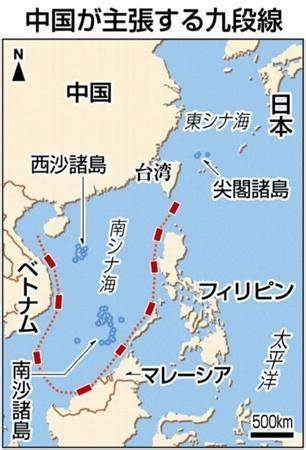 ■ US military bases in the Philippines to withdraw :China to claim sovereignty over the South China Sea
■ US military bases in the Philippines to withdraw :China to claim sovereignty over the South China Sea
The first threat from China was the 1992 Law of the People's Republic of China's Territorial Waters and Contiguous Zone , which declared sovereignty over almost the entire South China Sea . Vietnam, the Philippines, Taiwan, Indonesia, Malaysia, and Brunei, which surround the South China Sea, protested China's claim to maritime interests, known as the nine-dash line. China considers the area a strategic military stronghold, not only because it is rich in mineral resources such as oil and natural gas and a good fishing ground, but also because it has reclaimed seven reefs in the Spratly Islands in the South China Sea by 2015 to create artificial islands. The United States is wary of these islands, viewing them as military bases for the United States, and has called on its allies to conduct "Freedom of Navigation Operations (FONs)" to sail their own ships through China's territorial waters, which are treated as the front line of military tensions between the United States and China.
Why did China draw the Nine-Dash Line and declare sovereignty over almost the entire South China Sea, even at the risk of aggravating territorial disputes with the Southeast Asian countries bordering the South China Sea? It is not necessarily accurate to see this as hegemonic or imperialistic expansion. First of all, it was a recovery from 150 years of humiliation brought about by the invasions of great powers, including Japan, since the First Opium War in 1840. Furthermore, since the end of the 19th century, the United States, which viewed the Pacific Ocean as a new frontier, advanced westward, colonized the Philippines, and used it as a bridgehead to China, was clearly going to do everything in its power to destroy Communist rule in China after the collapse of the Soviet Union.
Then, in 1986, the dictator Marcos was ousted and a democratization movement broke out in the Philippines, which led to the withdrawal of US bases in the Philippines. In 1991, the Philippine Senate rejected the ratification of the New Bases Leasing Treaty, and by the end of 1992, US forces had completely withdrawn from Clark, Subic and other Philippine bases, which were said to be the "largest US bases outside the US." The enforcement of the Territorial Waters Law and the drawing of the nine-dash line were carried out as a golden opportunity to withdraw US forces from the Philippines, which were the greatest threat to China 's security. The Chinese leadership, who viewed the 1989 Tiananmen Square incident as a US plot to dismantle Communist China , likely used the South China Sea as a base for their offensive against the US and tried to drive the US military out of the Western Pacific. This is because they must have realized that the US was trying to transform China into a subservient US regime by supporting the democratization movement.
It is unclear whether Washington could have anticipated Beijing's enforcement of the Chinese Territorial Waters Law, which would come at the expense of the loss of the US military presence in the Philippines. However , at the time, the Association of Southeast Asian Nations (ASEAN) summit and other events led to voices being raised saying that "the military vacuum in the South China Sea poses an unprecedented security threat to the free world" (Philippine President Ramos), and international public opinion was critical of China's "outrageous actions." Within 10 years, the " China threat" had become a major campaign, and in the run-up to the 2008 Beijing Olympics, human rights issues in Tibet and Xinjiang, the Uyghur region, and other issues sparked anti-China international public opinion , followed by the Umbrella Movement, which protested the destruction of Hong Kong's high degree of autonomy. The US has been shaking up Beijing by channeling the abundant funds of the National Endowment for Democracy (NED) under the pretext of supporting NGOs. In the past 10 years, a Chinese invasion of Taiwan, i.e. a Taiwan emergency, has been fanned as a "tense issue." The "maneuvers to dismantle Communist China" have become extremely fierce.
■ China's maritime expansion: The United States supports its naval modernization
The reform and opening policy that China implemented in 1978 was not limited to the economic aspect. It also involved the opening up of the Chinese military to the Pacific Ocean and the reform and modernization of the military . In the 1980s, Deng Xiaoping ordered his trusted naval admiral Liu Huaqing to formulate a delayed naval modernization plan. From 1989, when the Tiananmen Square incident occurred, to 1997, China's military expansion began in earnest, and the PLA's equipment was rapidly updated. China declared the South China Sea its "own sea," and in the early 1990s, it began providing development assistance to island nations in the Western Pacific. By 2022, it had signed a security agreement with the Solomon Islands and was negotiating agreements with two island nations, significantly strengthening its influence in the Pacific Ocean.
This is the "Chinese maritime advance" that has the US and Europe wary. The Chinese leadership is attempting to replace the US in a dominant position, at least in the waters of the Western Pacific. What was groundbreaking was that when then-Commander of the US Pacific Fleet Admiral Keating visited China in May 2007 , he was approached by a senior Chinese naval official who proposed that the US military control the area east of Hawaii and the Chinese navy control the area west of Hawaii. Furthermore, then- US Secretary of State Clinton revealed in 2012 that "when we once discussed the issue of sovereignty over the South China Sea with China, the Chinese side said that they could 'claim (sovereignty over) Hawaii.'"
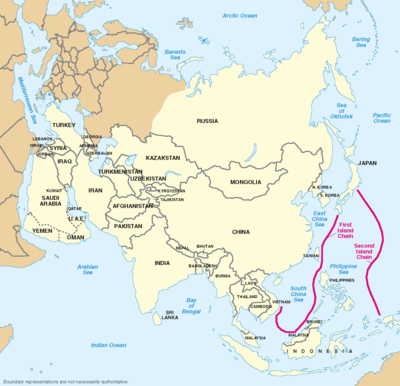 Liu Huaqing defined the first island chain as a defense line that can prevent enemy forces from invading the interior, and the second island chain as a line that starts from the Izu Islands, passes through the Mariana Islands, and reaches Papua New Guinea , where the Chinese Navy is presumed to prevent and obstruct reinforcements from the US Navy in the event of a Taiwan emergency . The US side believes that the two defense lines will be completed by 2020. China's current maritime strategy, which is an extension of its active defense strategy , is called the Anti-Access/Area Denial Strategy (A2AD), and it is conducting joint land, sea, and air exercises in Japan, East Asia, Oceania, and the Indian Ocean, mobilizing not only Japan and Australia but also the UK's state-of-the-art aircraft carrier Queen Elizabeth, as well as the military forces of France, Germany, and the Netherlands. Western media, including Japan, are constantly fanning the flames of the Chinese threat, and are now hyping up the possibility that the Taiwan Strait, the Senkaku Islands, and the Nansei Islands could fall into a state of emergency at any time.
Liu Huaqing defined the first island chain as a defense line that can prevent enemy forces from invading the interior, and the second island chain as a line that starts from the Izu Islands, passes through the Mariana Islands, and reaches Papua New Guinea , where the Chinese Navy is presumed to prevent and obstruct reinforcements from the US Navy in the event of a Taiwan emergency . The US side believes that the two defense lines will be completed by 2020. China's current maritime strategy, which is an extension of its active defense strategy , is called the Anti-Access/Area Denial Strategy (A2AD), and it is conducting joint land, sea, and air exercises in Japan, East Asia, Oceania, and the Indian Ocean, mobilizing not only Japan and Australia but also the UK's state-of-the-art aircraft carrier Queen Elizabeth, as well as the military forces of France, Germany, and the Netherlands. Western media, including Japan, are constantly fanning the flames of the Chinese threat, and are now hyping up the possibility that the Taiwan Strait, the Senkaku Islands, and the Nansei Islands could fall into a state of emergency at any time.
In fact, when China started modernizing its navy, the United States assisted it. The reason for this is unclear. A sharp increase in imports of energy resources was essential for economic development in the wake of the Reform and Opening-up policy. At the time, China's naval power was virtually insignificant compared to that of the Soviet Union, the virtual enemy of both countries, and there was still time before the Tiananmen Square incident, which would have worsened U.S.-China relations. There seems to have been no hesitation in seeking U.S. help in drastically strengthening naval power to "protect sea lanes and maritime interests." The U.S. must have also thought that this would give them an advantage in investing in China. However, China's subsequent economic growth was more spectacular than anyone could have imagined.
■ China or the US: Which is the bigger threat ?
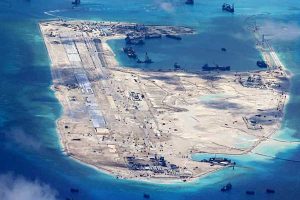 From the Chinese perspective, the threat is the United States. The artificial islands built on seven reefs in the Spratly Islands in the South China Sea (photo) will be defensive bases against invasion by the United States and its allies. Although it is too unreasonable and violent in light of international law, it is a natural measure to defend China from the US military approaching the Chinese coast.
From the Chinese perspective, the threat is the United States. The artificial islands built on seven reefs in the Spratly Islands in the South China Sea (photo) will be defensive bases against invasion by the United States and its allies. Although it is too unreasonable and violent in light of international law, it is a natural measure to defend China from the US military approaching the Chinese coast.
China has been on edge over the activities of the US and its allies in the Taiwan Strait and the South China Sea, known as FONs. Chinese experts have criticized the move, saying, "Imagine Chinese ships sailing along US territorial waters in the Gulf of Mexico and Chinese military aircraft flying right on the edge of US airspace" (Fudan University Center for American Studies). In the midst of this, on April 1, 2001, a US military aircraft collided with a Chinese military aircraft in the air over the South China Sea near Hainan Island, China. The Chinese pilot went missing, the US's damaged electronic reconnaissance aircraft made an emergency landing on Hainan Island, and the pilot was taken into custody by the Chinese side. It appears that such provocative flights by US military aircraft had become commonplace.
China strongly criticized the US military plane for violating its territorial airspace and making a sharp turn intentionally, which led to the collision. The US government responded by saying that the collision was caused by provocative actions by the Chinese military plane, and demanded the immediate return of the crew and the aircraft. However , the US later sent a letter of apology to China and released the crew . This incident solidified China's distrust and dissatisfaction with the US.
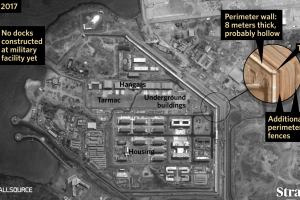
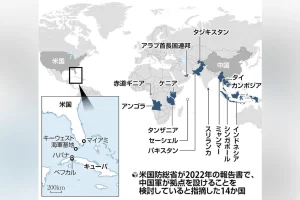 Twenty years have passed since then. China has embarked on a countermeasure against the United States , setting up a military base in friendly Caribbean nation Cuba by the end of 2023 (see photo) . US media has refrained from reporting it as a major incident, viewing it as a "training base" or "spy base." In any case, a preparation has been made for an attack on the nearby US mainland across the Gulf of Mexico. If China were to move to deploy nuclear weapons, even tactical ones, at Cuban military facilities, tensions between the US and China would rise to an unprecedented level, resulting in a repeat of the Cuban Missile Crisis of 1962. Publicly, both the US government and the media continue to "pretend to watch and wait."
Twenty years have passed since then. China has embarked on a countermeasure against the United States , setting up a military base in friendly Caribbean nation Cuba by the end of 2023 (see photo) . US media has refrained from reporting it as a major incident, viewing it as a "training base" or "spy base." In any case, a preparation has been made for an attack on the nearby US mainland across the Gulf of Mexico. If China were to move to deploy nuclear weapons, even tactical ones, at Cuban military facilities, tensions between the US and China would rise to an unprecedented level, resulting in a repeat of the Cuban Missile Crisis of 1962. Publicly, both the US government and the media continue to "pretend to watch and wait."
■ US military presence shrinks, US defense industry booms due to war boom
At the end of February, when asked about how to respond to a Taiwan emergency, US President Trump replied, "I will not comment." Specifically, he said, "I do not want to be put in a situation where China takes Taiwan by force, so I will not comment at all." He also said, "I have a great relationship with Chinese President Xi Jinping. I want them to invest in America." China is a major economic rival, but this means that he has expressed his intention not to confront it by force. Trump, who puts "America First," has "no intention of fighting a fierce battle with China. He will do his best to surpass China in science and technology and corporate competitiveness and maintain the US's advantage." He has dismissed the Chinese invasion of Taiwan and the Taiwan emergency as just a media fuss.
The National Security Strategy announced at the end of 2017 under Trump's first administration revised the previous "engagement" policy toward China, which aimed to strengthen the partnership with the country, and set out a policy of confronting China in the fields of military, diplomacy, economy, and science and technology. This was because the administration had been taken over by ultra-hawkish neoconservatives such as Secretary of State Pompeo, Vice President Pence, and National Security Advisor Bolton, who had declared a cold war against China. Reflecting on this, the second administration has lined up to negate the cold war declaration.
On the other hand, this blog has frequently mentioned the Japan emergency (Senkaku/Ryuto Islands crisis) that is integrated with the Taiwan emergency in recent years. Most recently, in the article published on January 30th, " Trump prioritizes the Western Hemisphere and excludes China: In East Asia, US troops in Japan will be reduced and may withdraw from South Korea," I wrote the following in the section "
■ Withdrawal from East Asia, reestablishment of hegemony."
"What will happen to Japan? This blog has repeatedly discussed the Taiwan/Senkaku crisis and the US offshore balancing strategy. In the event of a Senkaku crisis, Article 5 of the Security Treaty is meaningless, and it is almost 100% impossible for the US to take action. The real intention of the US is that "China is unlikely to invade Taiwan," "the same goes for a Senkaku crisis," and "if one does occur, we will make Japan fight." What the DS, known as the military-industrial complex, including the US defense industry, wants is for tensions to continue to be stoked and for them to profit. On January 27, 2025 , Russia RT reported that " US arms exports in 2023 accounted for 42% of the world's total . "
According to CNN, the United States is widening its lead as the world's largest arms exporter. Europe is now its main destination. According to the latest statistics released by the Stockholm International Peace Research Institute, the United States accounted for 43% of global arms exports from 2020 to 2024, more than four times that of France, the second-place country. From 2015 to 2019, the United States' share was 35%. In other words, it is a special demand due to the Ukraine war. According to statistics for the past five years, including 2022, when the war began, almost two-thirds of the weapons imported by European NATO member countries were made in the United States. From 2015 to 2019, it was about half . Japan's defense industry, which has become a subcontractor for the US military industry, has revised the "Three Principles on Transfer of Defense Equipment and Technology," but is only able to re-export the US Patriot interceptor missile, which was licensed and produced in Japan, to the United States, and is being used by the US military industry.
■ "Become rich by attracting the Self-Defense Forces"
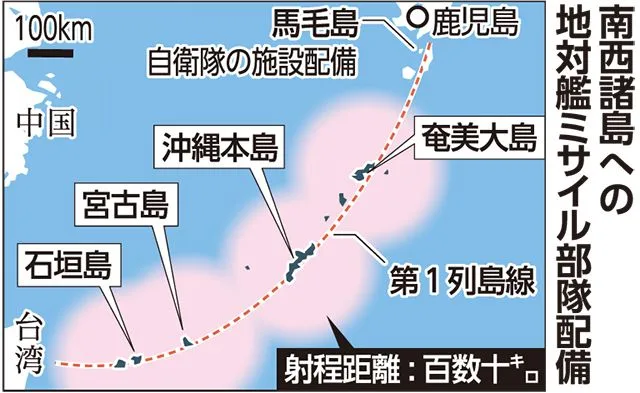 Just like the boy who cried wolf, the US military-industrial complex and the media are relentlessly stirring up fears, saying, "The wolf is coming," and both the Japanese government and public opinion are being manipulated. The former mayor of Miyakojima, who was found guilty of bribery for accepting cash in return for facilitating the sale of land for the Self-Defense Forces to use, is still not shy about saying, "Attracting the Self-Defense Forces has freed us from poverty," even after his conviction. A resident of Miyakojima said, "The atmosphere has become one in which it is no longer possible to voice opposition to the deployment of GSDF missiles." The frontline island facing China is a microcosm of modern Japanese society.
Just like the boy who cried wolf, the US military-industrial complex and the media are relentlessly stirring up fears, saying, "The wolf is coming," and both the Japanese government and public opinion are being manipulated. The former mayor of Miyakojima, who was found guilty of bribery for accepting cash in return for facilitating the sale of land for the Self-Defense Forces to use, is still not shy about saying, "Attracting the Self-Defense Forces has freed us from poverty," even after his conviction. A resident of Miyakojima said, "The atmosphere has become one in which it is no longer possible to voice opposition to the deployment of GSDF missiles." The frontline island facing China is a microcosm of modern Japanese society.
